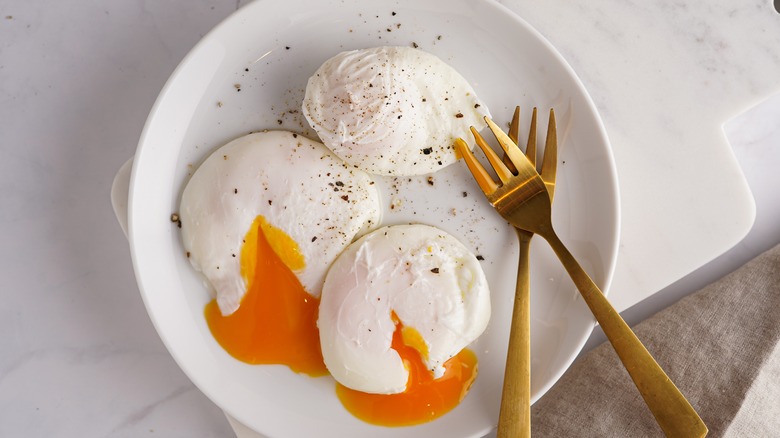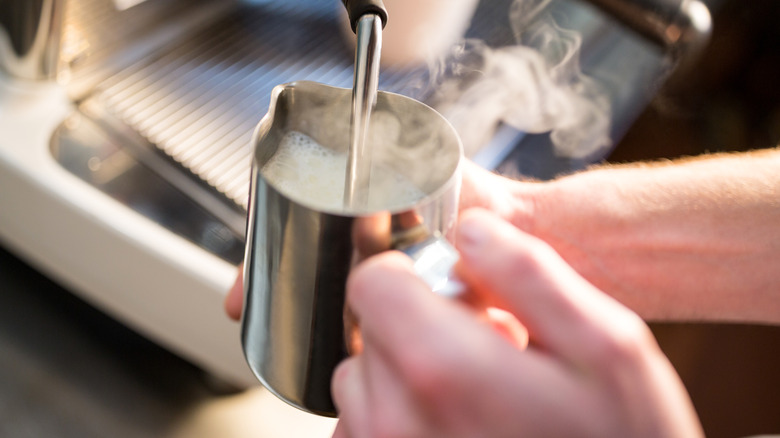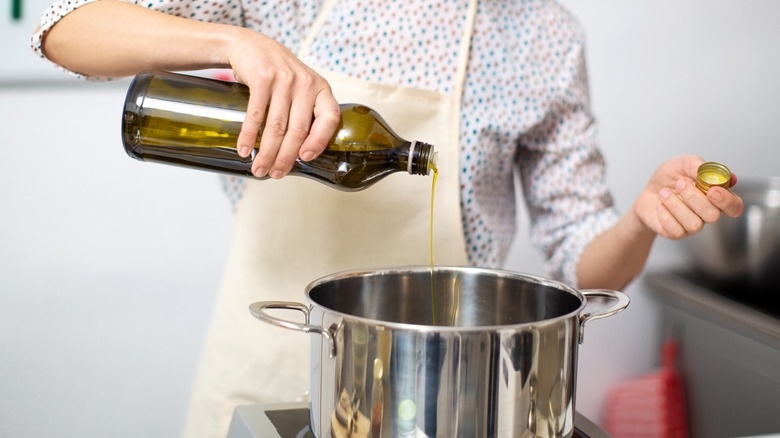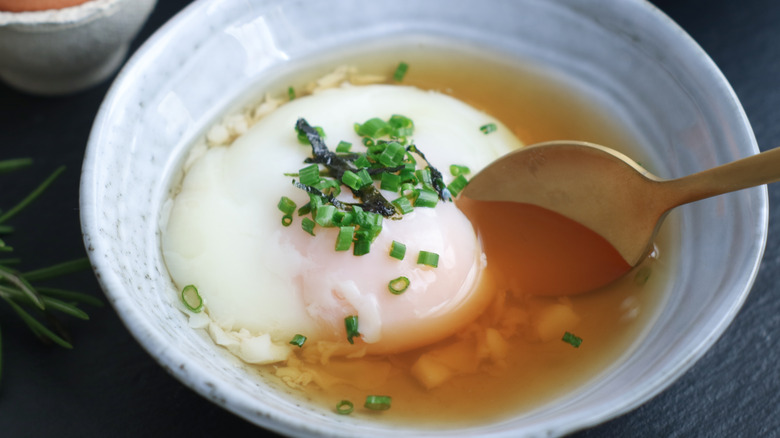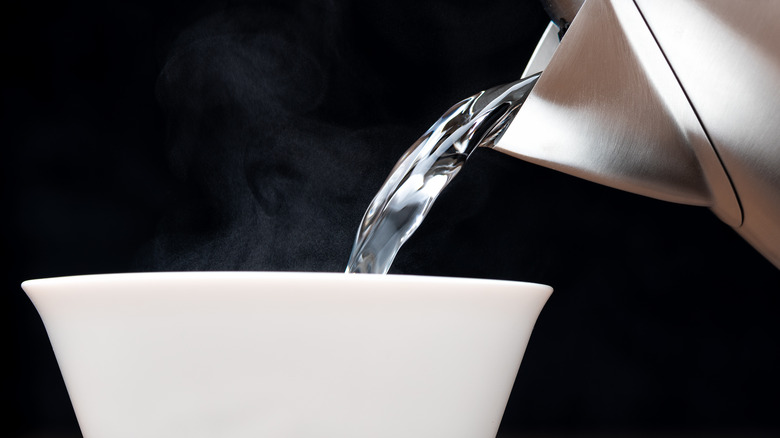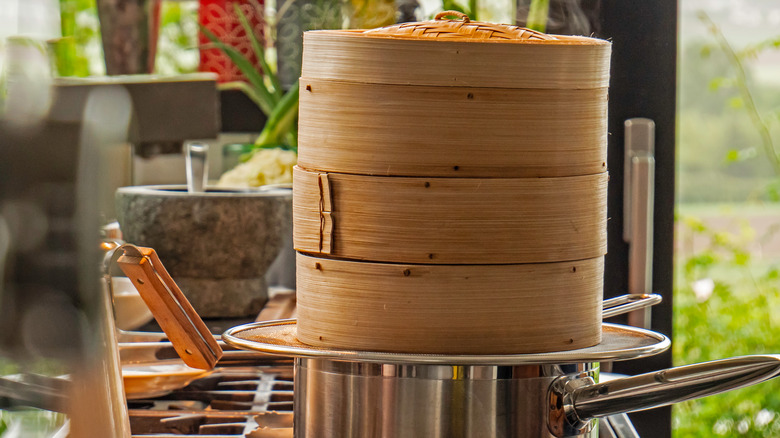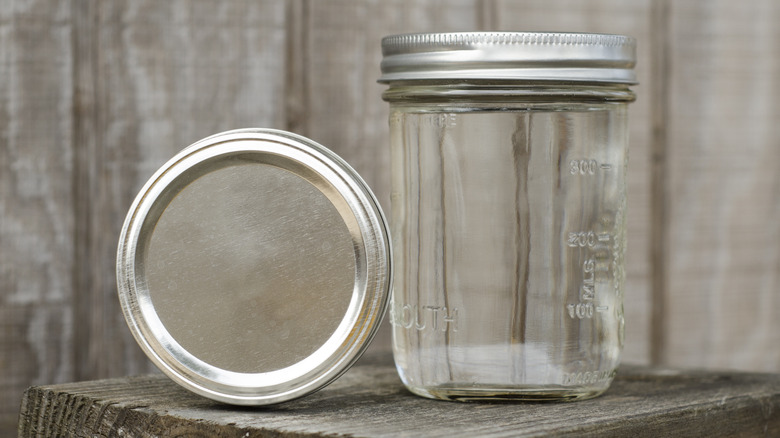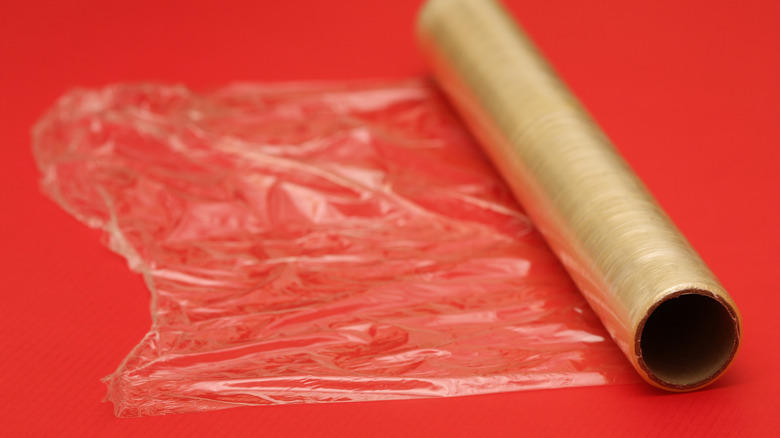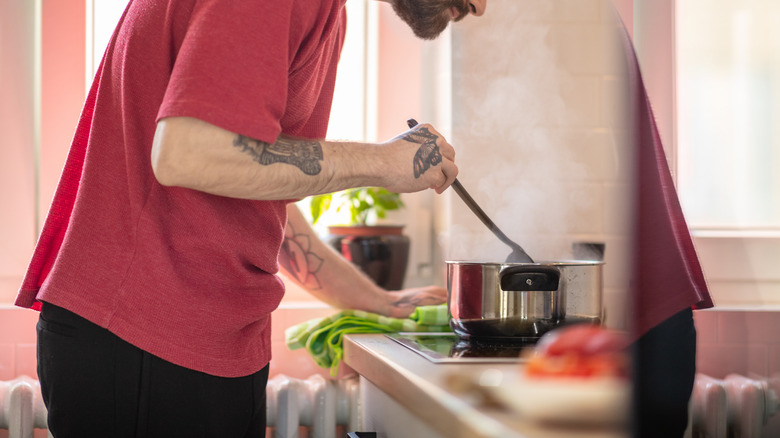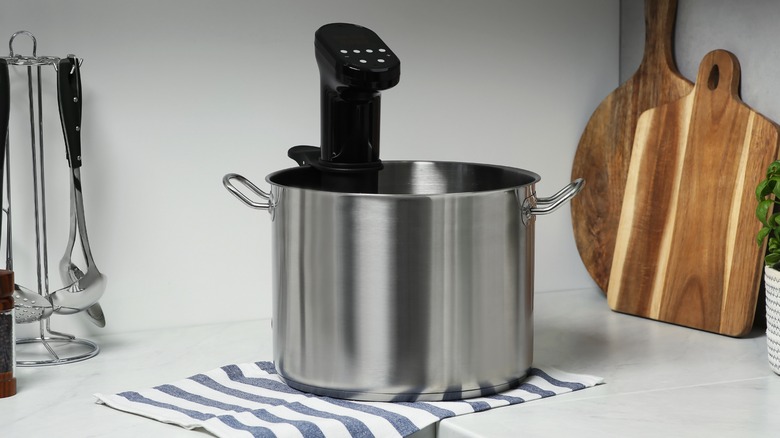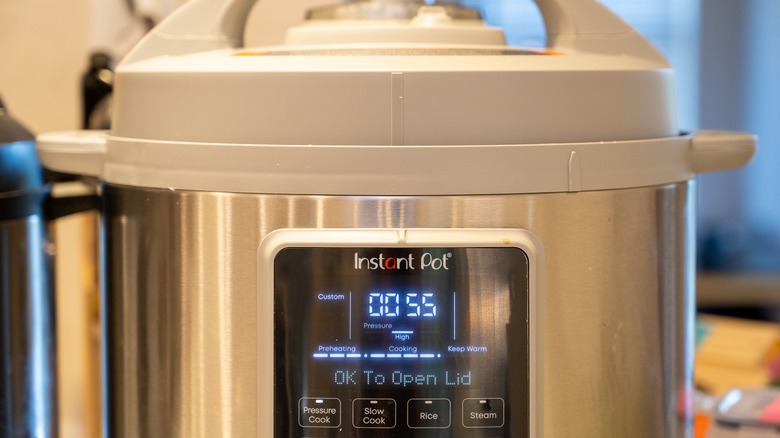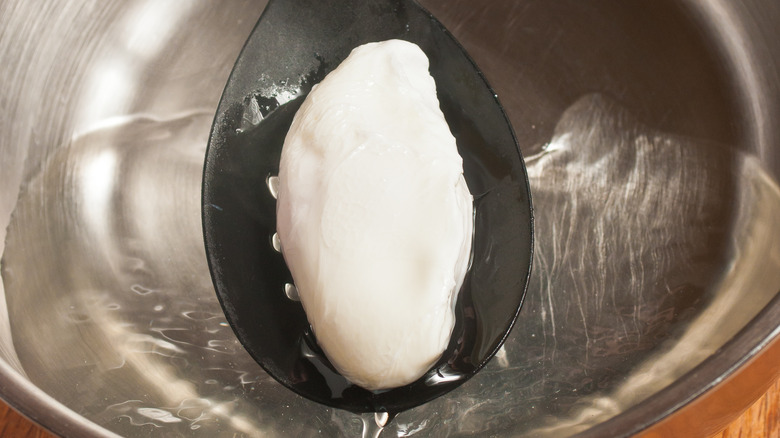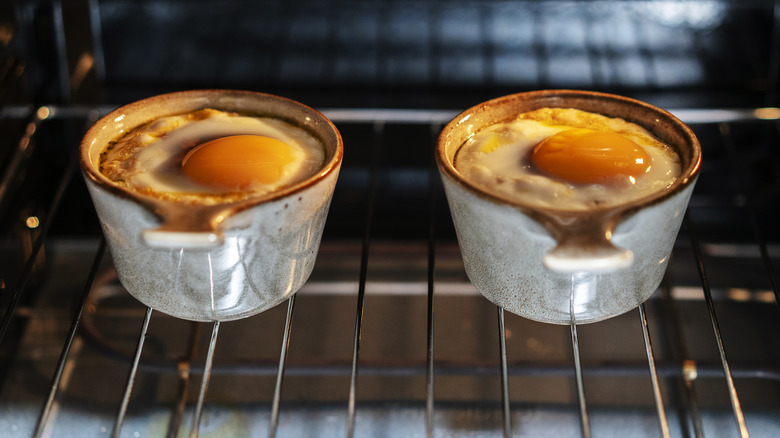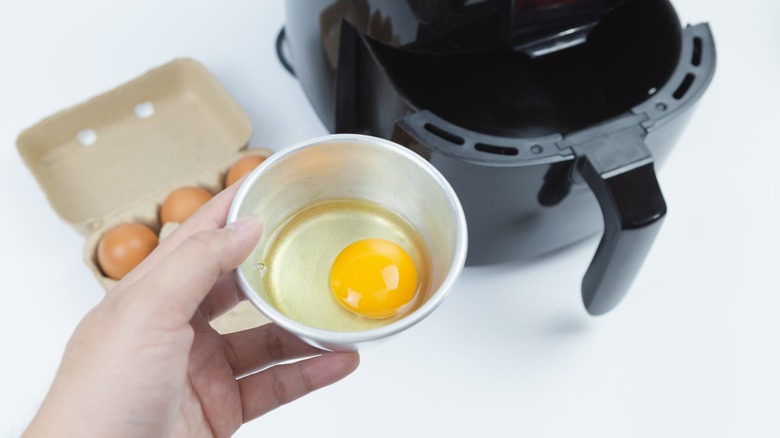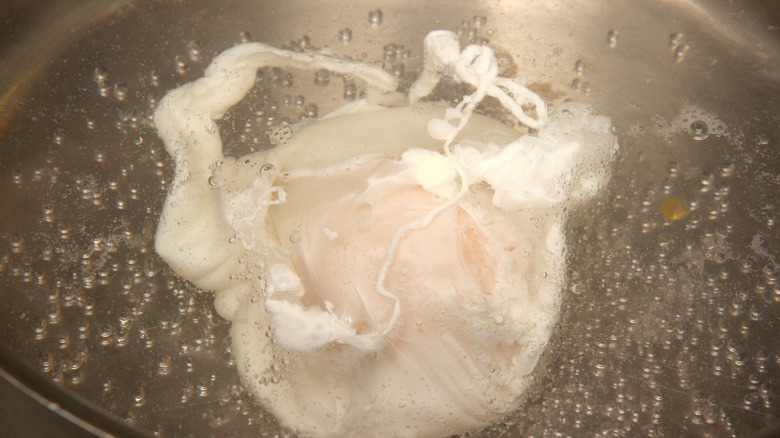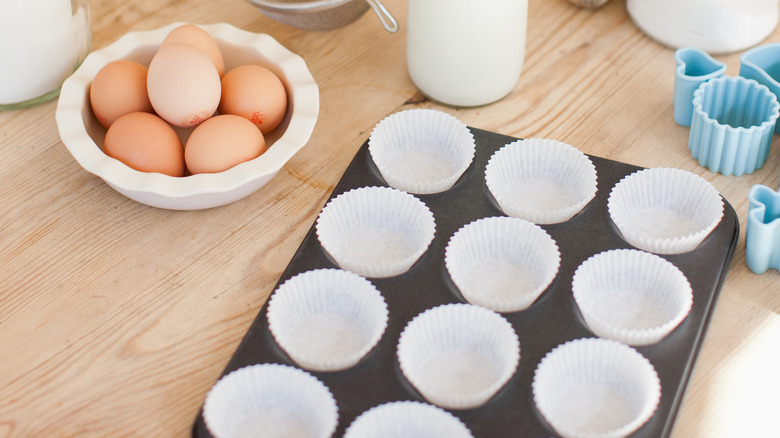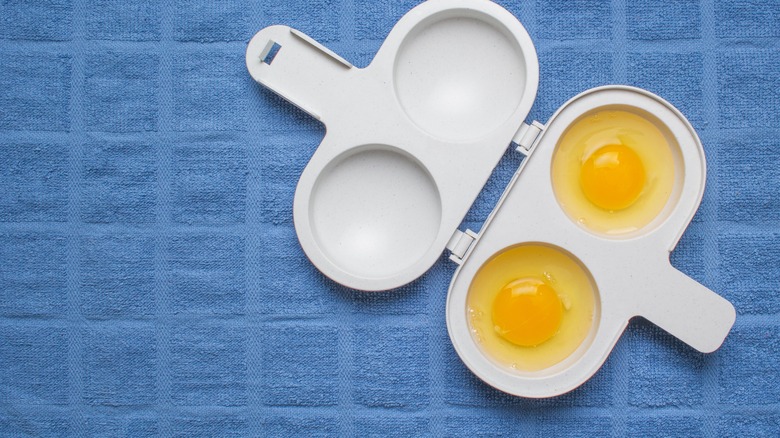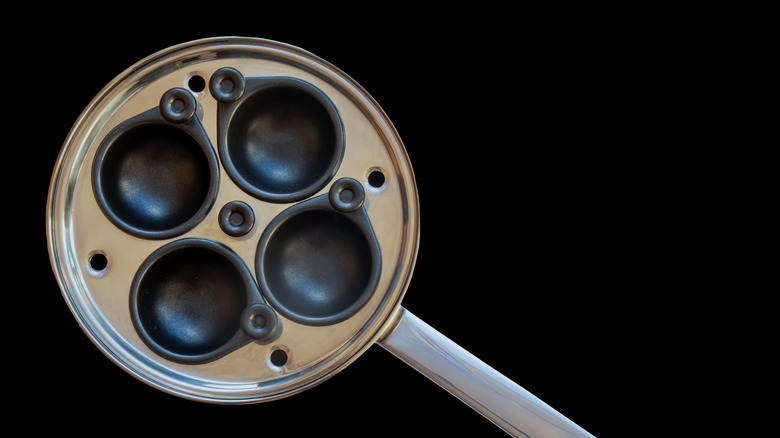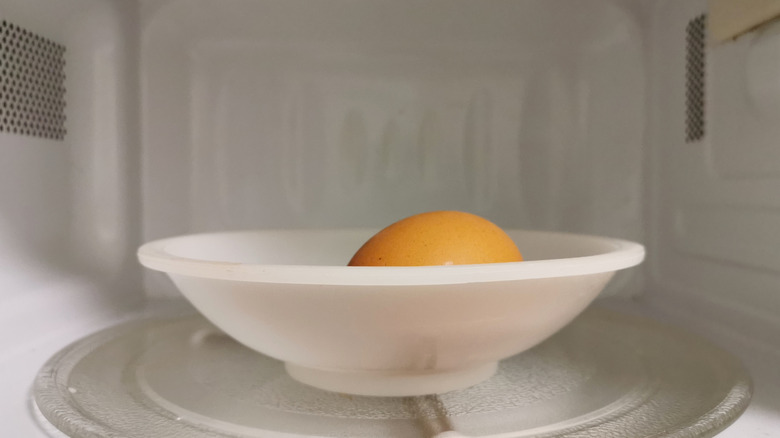20 Ways To Poach Eggs Ranked
Poached eggs are a breakfast delicacy that many love, but despite the apparent simplicity of this cooking method, we don't always have the courage or skill to make it perfectly every single time. Yet nothing is more satisfying than getting that luscious, oozing center encased in a perfectly set white, whether you're a poached egg expert or not.
Beyond the good old stovetop method, there are plenty of other poaching techniques to explore. We've looked at some of the many ways to poach eggs and have ranked them according to a few key factors: ease and convenience, consistency of results, flavor and texture, reliability, cooking time, novelty, and any additional ingredients or equipment required. The more accessible and foolproof the poaching method, the higher it soared on our list.
From the downright quirky to the steadfastly traditional, let's discover the best and, well, not-so-best ways to achieve poached egg perfection.
20. With an espresso machine steamer
Yep, you heard that right. If you were already making coffee for your breakfast, why not make it even easier by pairing it with a poached egg via an all-in-one machine? Though it may sound like an early morning mishap or an affront to the coffee-making Puritans of the world, the steamer on an espresso machine (known best for frothing milk for your morning latte) can help you maintain a gentle, continuous whirlpool of steamy water that will evenly poach your eggs. This results in a slightly loose egg that's perfect for the runny yolk lovers out there.
However, aside from the possible odd look from family members as you poach eggs with your espresso machine, the consistency might not be on par with what's produced by more conventional methods — it's designed to froth milk, after all. Unless you want a quirky brunch conversation starter, it's best to reserve your expensive espresso machine for its coffee duties and look elsewhere for poaching. Coffee and eggs might be breakfast staples, but perhaps they shouldn't mix in this particular manner!
19. In wine
If we're talking about unconventional ways to poach eggs, dipping them into a decadent pot of wine is certainly one of the more unorthodox methods. But for the adventurous souls looking to blend the sophisticated flavors of a fine vino with their eggs, this method offers a tasteful twist.
Practically speaking, the poaching process remains similar to the traditional method, only substituting wine for water. This promises to impart a unique flavor to the egg, wrapping it in notes of oak, fruit, and tannins depending on the wine.
But this taste might not be everyone's cup of tea — or in this case, glass of wine. Furthermore, the wine's quality plays a crucial role here. A low-grade bottle might render the egg less than palatable, while splurging on a top-tier wine for poaching can make you question why you used it on eggs, of all things. Still, if you're seeking the dinner date version of this dish, wine-poached eggs could be worthy of raising a toast.
18. In olive oil
With a luxurious and decidedly Mediterranean ingredient at hand, your expectations may soar when you begin to consider poaching eggs in olive oil. Also known as confit, this method ensures that the eggs come out rich and velvety, the white protecting a runny yolk that is infused with the grassy notes of a good olive oil.
However, for those used to a swift drop into boiling water, this method may feel labor-intensive, requiring vigilant temperature control and consistent basting to ensure the olive oil doesn't simply fry the egg. Additionally, if you're partial to that top-shelf extra-virgin bottle, submerging an egg in a pan filled with the stuff can be quite demanding. That's especially true if you only want one egg to go.
Poached eggs cooked in olive oil toe the line between indulgence and overindulgence. For daily breakfast needs, it might be best to reserve your olive oil for dressing salads and toasting bruschetta, unless you like the taste of olives, of course.
17. In broth or soup
If you are someone who frequently cooks soups or who always has some broth handy, you can elevate your sometimes watery poached eggs by simply replacing the water with savory broth or a well-crafted soup. That way, you can give your poached egg a delectable savory dimension. What makes this method even better is how it can help you pack the already protein-rich egg with even more nutrients.
However, while the result can be delicious, especially when using a fragrant chicken or beef broth, achieving consistent results might be a struggle. The thickness of the soup or broth you're using could significantly affect the poaching process, for instance, as would the quality.
Still, if the thought of the taste and softness of a poached egg seamlessly blending with the richness of broth is mouthwatering, then this sustainable and flavor-packed method may still be worth a try.
16. Pouring water over the eggs
You know how you're supposed to drop the eggs into hot water to poach them? Well, have you tried doing it the other way around? Allegedly, this not-too-common method ensures that you never fail to achieve a perfectly soft and velvety poached egg.
The beauty of this method is that, in the absence of aggressively bubbling water, you can't drop your eggs and spill or splash scalding water while also poaching your eggs successfully. By simply pouring hot water over a cracked egg that's waiting in a bowl, you can leave it to do its thing and be left with a perfectly silky poached egg.
That being said, this hack does elicit controversy and comments from those who think this method takes no skill at all. Some even say the result isn't poached at all, but is a soft-boiled egg cooked out of its shell.
15. Using a steamer
Whether you only have a mesh sieve on a stovetop or a dedicated steamer basket on hand, steaming your eggs promises gentle, even cooking which should yield delicate, tender poached eggs.
This gentle method is simpler because it eliminates the need for scooping the eggs from hot, swirling water. Additionally, because eggs have practically no direct contact with water, you can reduce the watery taste that you may find with other methods, instead emerging with a commendable creaminess — all while eliminating the need to watch the simmering water like a hawk.
However, with simple steaming, you can't easily add new flavors, unlike some of the other methods in the list. This can be good or bad depending on your preference and enjoyment of eggs on their own. Still, since steaming your veggies is generally deemed superior when it comes to texture and taste, maybe the same can be said for poached eggs.
14. Using the mason jar lid method
Have you ever stumbled upon a neat kitchen hack and thought, "Why didn't I think of this sooner?" The next time you're in the mood for a poached egg, consider giving that mason jar in your kitchen a second, more purposeful glance. With the mason jar method of poaching eggs, you use the ring of its lid as a mold to produce a more predictable egg every time.
This is because the mason jar ring gives you more control over the shape of your egg, leading to consistent, Instagram-worthy results. Plus, if you're making multiple poached eggs, this method can allow more eggs to fit inside your pot. The downsides? If you don't own mason jars, you'll need to invest in some (or the lids, at least). Then there's the added step of cleaning the rings after use. Eggs can be a sticky business, after all.
Yet, poaching eggs with the help of a mason jar lid is a game changer for many, offering predictability and picture-perfect results, especially for those home cooks who are afraid of breaking their eggs in the water to create a mess of egg white tentacles.
13. Using plastic wrap
The whole idea of a poached egg is to cook the egg outside of its shell, so seeing a poached egg emerge from a clear plastic cocoon may be an odd sight. But for some, the idea is rather ingenious with how it takes all the effort from the poaching process. You create a tiny pouch with the wrap, nestle the egg inside, and seal it to keep its shape while it simmers to delicate perfection.
However, this method is not without its challenges. For even the best of us, cracking eggshells perfectly can still be a nerve-wracking endeavor, so wrapping the egg is tricky. Moreover, you have to ensure that the plastic doesn't come undone or melt in the process.
Plastic wrap does add hassle in terms of prep, but if you're after a beautifully shaped poached egg, it can be an unexpected yet effective tool — at least once you've got the hang of this method.
12. Using the whirlpool method
We've all heard how the vortex created by the traditional water swirling technique draws the egg towards the center of the pot and perfectly wraps the white around the yolk. It's supposed to make for a tidier, more compact poached egg, but while it's entertaining to watch eggs ride whirlpools in a pot, one false move and you're left with chaotic strings of egg whites that are foaming all over the place.
However, in the grand spectrum of poaching methods, the whirlpool technique is still a classic. There are no additional ingredients or equipment required being your egg, a bowl, a pot, and a slotted spoon needed to both create the swirl and fish that beautifully poached egg out of the water. This technique can provide consistent results once you've gotten the hang of how intense the swirling should be. That means delicate whirls only please, lest you want the scalding spray of poaching liquid on your skin!
11. Using a strainer
For those seeking to achieve the smoothest result, the strainer technique is the secret method for perfect poached eggs. By employing a fine-mesh strainer, you can ensure that your egg is free from shells or chalaza – that's the tiny white string that connects the yolk to the egg white. You'll ideally eliminate all wisps of whites that would otherwise ruin the aesthetic of your Instagrammable breakfast.
However, like many kitchen techniques in this list, mastery demands practice for more control over the egg's shape and purity. You'll also have to wash more dishes, given that you strain the eggs before poaching them. But for those who covet picture-perfect poached eggs, the extra effort is a small price to pay. So, the next time you're aiming for a flawless finish, fish out that strainer you generally reserve for pasta. You'll have your followers swooning over your impeccably poached egg in no time.
10. With a sous vide cooker
When you want poached egg precision, the sous vide or immersion circulation method is the golden ticket. With the sous vide method, just set your desired time and temperature, drop your eggs into the water bath, and let the machine work its magic. The hands-off nature of this technique affords you the luxury to shift your focus to complementary dishes. Talk about efficiency!
However, the specialized equipment needed makes this method less accessible, seeing as not everyone has an immersion circulator tucked away in their kitchen. So, while this technique is a chef's saving grace, casual cooks might find the equipment investment a bit much, especially for eggs alone.
If you're hunting for poached egg perfection and have a penchant for precision, the sous vide route is the most obvious choice. For those without the necessary tools, however, we will leave the spending decisions up to you.
9. With an Instant Pot or pressure cooker
Poached eggs, while a seemingly simple dish, can test the patience of even the most seasoned cooks. Consider how you always have to be watching over the temperature, swirling the water meticulously, checking on how cooked the eggs are, and watching for the foamy water to spill over. But with the Instant Pot, you can achieve perfection with minimal effort.
To achieve beautifully poached eggs with an Instant Pot or pressure cooker, simply add water, place your egg-filled bowls inside, and let the machine do its thing. With either device, a hands-off cooking approach and a perfectly soft yolk are nearly guaranteed.
If you don't have either device, a simple pot or pan, plus some additional elbow grease, can do the trick. But for those equipped with this nifty device — we're looking at you soup and stew enthusiasts — poaching eggs has never been easier.
8. Using a ladle or slotted spoon
When it comes to simplicity and efficiency in the world of egg poaching, a deep ladle or slotted spoon has rarely failed us. Despite being a way-too-obvious method, this hack could be one of the easiest on the list. The gentle curve of a ladle minimizes the risk of the yolk breaking, while the slotted spoon ensures that any excess water flows away. The result? A perfectly shaped poached egg that's waiting to be nestled atop your next eggs Benedict.
Chances are good that you already own a ladle or slotted spoon, making this technique not just practical, but incredibly convenient and accessible. So if you haven't given this method a whirl yet, the question lingers: why not? With a reliable tool that's already within reach, and the promise of a perfectly spherical egg nearly guaranteed, what's holding you back from trying this poaching hack?
7. Baked in the oven
The trick to making poached eggs in the oven has everything to do with control. You decide precisely how runny or firm you'd like your yolks, and without the frenzy that a pot of boiling water can bring. However, this leisurely poaching experience comes at the slight expense of time. While other methods might rush to deliver results, the oven insists that you savor the anticipation. The extended cooking time might seem like a setback, especially if you're famished and craving that golden yolk right away. But for those who champion precision over promptness, this method is ideal.
There's an elegant predictability to the process, too. No whirlpools or risky water depths here. Instead, you'll find an oven-safe dish, some water, and, of course, your egg. It's almost poetic in its simplicity. Just remember to set a timer, because while the oven method is straightforward, it's also easy to lose track of time and turn your delicate poach into a hard-boiled disappointment.
The baked method may not be your everyday go-to — especially if you're in a rush — but for weekend brunches or a fancy breakfast in bed, it offers artistry that's hard to beat. Dive in and be a part of the slow food movement. Sometimes, the best things take a little more time.
6. In an air fryer
Ah, the air fryer. For modern cooks, it's the quintessential kitchen gadget that's stormed countertops worldwide. Of course, its proponents would claim that it can poach eggs like no other device. Turning to an air fryer for poaching not only offers a break from the traditional stovetop hustle but also promises a consistency that can be otherwise hard to achieve. For perfect air fryer poached eggs, temperature is key. Given how an air fryer uniformly circulates hot air, it helps to ensure an evenly cooked delight every time, making overdone yolks or rubbery whites a thing of the past.
What sets the air fryer method apart is its sheer simplicity and convenience. The ability to produce multiple poached eggs simultaneously is a boon for those hosting breakfasts or brunches, too. And the tools? Minimal. All you need is a set of ramekins in addition to the air fryer itself. Place your eggs inside and let your trusty air fryer transform them into a velvety delicacy.
5. Using the classic stovetop method
Let's get real — some methods stand the test of time for a good reason. By using the classic stovetop method, perhaps with a splash of white vinegar for cohesion and seasoning, the taste you get is purely egg, unadulterated by extra ingredients or additional flavorings. Plus, you don't need to spend any money on a fancy new kitchen gadget. All it takes is practice, patience, and the willingness to leave a bit of room for error.
Sure, there might be an occasional misfire when the egg white disperses a little too much throughout the roiling water, and this method might not have the technological edge or internet viral potential of the other hacks on this list. Yet it's consistent, reliable, and the most accessible poaching method for almost everyone, making the old-school stovetop technique the gold standard of poaching for many. Why mess with something that already works?
4. In a muffin tin
Are you poaching eggs en masse? Look no further than your baking equipment cupboard if you want dozens of poached eggs ready all at once. Instead of juggling multiple pots and ladles, all you need is a muffin tin (surely one of the more commonly found baking tools) to serve as your shortcut to egg poaching glory. Each cup in the tin offers a controlled environment to get that egg poached just right.
However, while this method may be convenient, it's worth noting that each cup can vary slightly in heat distribution, leading to some eggs that are perfectly poached while others might resemble over-medium skillet eggs. That said, the process is quite straightforward. Fill each cup with water, add the egg, and allow the oven to delicately set the whites while keeping the yolks gloriously runny. The result? Perfectly round eggs that look lovely on toast.
3. Using silicone egg cups
While some would say that silicone egg poaching cups are an unnecessary kitchen gadget, the simplicity and reliability of these weird-looking little things can come in handy. Simply crack your egg into one, then lower it gently into simmering water and let the magic happen. Whether you're aiming for a loose yolk or something a bit more firm, the egg will find its perfect shape when snuggled within these moldable cups.
Perhaps more importantly, these poachers do more than just ensure a mess-free poaching process. When it's time to plate up, they promise a seamless escape with no struggle and no mess. Your poached egg can effortlessly glide onto your plate, its shape and consistency intact — as long as you remember to butter your cups beforehand, of course. For those who are tired of the whirlpool method or the inconsistent outcomes of other techniques — and don't mind another piece of kitchen gear — these cups might just be your new breakfast best friend.
2. Using an electric egg poacher
You might wonder, especially in this age of kitchen gadget overload, if a specialized tool to poach eggs is really that necessary. However, if you've been finding yourself making poached eggs for all your breakfast needs every day, then this device may just be the surprising solution you didn't know you needed.
Gone are the days of fretting over water temperatures or questioning the doneness of your eggs. With an electric egg poacher, consistency is the name of the game. Especially for those busy mornings when multitasking is essential, or when hosting brunch, this tool is a true game-changer. No hovering over a pot, no second-guessing — just perfect poached eggs every time.
So, for those skeptical about adding another kitchen device to their collection, we say: give it a whirl. You might just find yourself won over, enjoying a golden stream of yolk cascading onto your plate with the kind of consistency only this method can provide.
1. In the microwave
Want your poached eggs in a jiffy? Microwaves might not be the first thing that comes to mind but, as it turns out, they should be. Ease and convenience are the keywords here, with just a bowl, a bit of water, a microwave, and voilà — poached egg perfection on your plate.
Forget about the whirlpools, strainers, and cluttered counter space. With a microwave, you only need a water-filled bowl to serve a ready-to-eat poached egg faster than you can toast your bread. However, overcooking or failing to learn about this method first can make your yolky dreams transform into a rubbery nightmare or worse, explode. So make sure you get your timing right and soon the consistency you achieve with the microwave will be impressive.
Microwaving is a fast, fuss-free, and downright effective way to get a dreamy poached egg. Trust us, you'd have it no other way.
